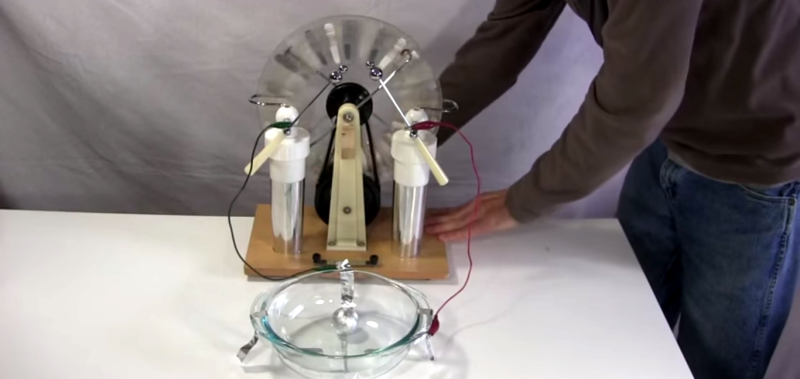Okay, not actually a cyclotron… but this ball cyclotron is a good model for what a cyclotron does and the concepts behind it feel kooky and magical. A pair of Ping Pong balls scream around a glass bowl thanks the repulsive forces of static electricity.
It’s no surprise that this comes from Rimstar, a source we’ve grown to equate with enthralling home lab experiments like the Ion Wind powered Star Trek Enterprise. Those following closely will know that most of [Steven Dufresne’s] experiments involve high voltage and this one is no different. The same Wimshurst Machine he used in the Tea Laser demo is brought in again for this one.
A glass bowl is used for its shape and properties as an insulator. A set of electrodes are added in the form of aluminum strips. These are given opposite charges using the Wimshurst machine. Ping Pong balls coated in conductive paint are light enough to be moved by the static fields, and a good crank gets them travelling in a very fast circuit around the bowl.
When you move a crank the thought of being connected to something with a chain pops into your mind. This feels very much the same, but there is no intuitive connection between the movement of the balls and your hand on the crank. Anyone need a prop for their Halloween party?
If you don’t want to buy or build a Wimshurst machine you can use a Van De Graaff generator. Can anyone suggest other HV sources that would work well here?
















Description in the video is misleading and wrong in some cases.
Why not explain what is wrong instead of just shouting?
+1
Now I am wondering what I just mis-learned. Please explain.
Spoken like a true engineer: 100% true, yet completely useless.
Danger—any DC HV source could be used. If it is high enough of course. Old CRT TV?
You can tape aluminum foil to the front surface of a large CRT screen, and draw high-voltage off that.
http://amasci.com/emotor/tvgen.html
HAD… What the heck? Cyclotron? Are you in deceptive advertisement now?
it’s a bycicle from tron.
That’s what they’re called “ball cyclotrons”. Neither HAD nor I made that up. If you don’t like that name, they’re also sometimes called electrostatic accelerators, which I get the feeling you won’t like either.
The first thing I noticed in the photo was the Wimshurst Machine and thought “That’s not a cyclotron, it’s not even close!”
Then reading the article and finding out the bowl is representing the cyclotron, I thought, “Wow! Good example!”